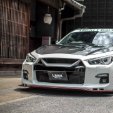Announcements
-
Similar Content
-
Latest Posts
-
By joshuaho96 · Posted
Any chance you can get a Nistune board installed instead and set the speed limit to whatever your tires can handle? -
By GoHashiriya · Posted
Hi all, I need to get this HKS SLD attached to my stock ECU because I've now got the German autobahn and faster European circuits to contend with. The car is a manual 2dr ER34 with an AT ECU and I've realised the AT ECU has two pins for speed sensor signals: Pin 29: Vehicle speed sensor signal (Vehicle speed sensor 2) Pin *58: Output shaft rotation sensor signal (Vehicle speed sensor 1) - *RB25DET A/T model only Before I go butchering this harness, is anyone sure of which pin is the correct one for signal adjustment? The attached document from HKS indicates pin 29 but I found this situation mentioned in the following thread on a different forum (R34 GTT Auto Trans Speed Cut Problem | Zerotohundred) mentioning pin 58 needing to be altered by member zephuros, albeit it seems to be for an RSM-GP and the info appears to be old. R34_All_Workshop_Manual-pages-2.pdf R34_All_Workshop_Manual-pages-3.pdf R34_All_Workshop_Manual-pages-1.pdf HKS SLD Vehicle Pin out P59-P70 ER34-pages.pdf -
Embrace the freedom of casual encounters on the best dating app in town! Verified Maidens Superlative Сasual Dating
-
Slimline sub on the rear parcel shelf is doable. Pioneer TS-WX140DA is only 70mm high.
-
People like Johnny Dose Bro might be laughing at my post because I accidentally added 100mm to my numbers. 350-355 is indeed the lower limit. 450 is off-road Skyline spec.
-


![[SKYHI]](http://saufiles.s3.ap-southeast-2.amazonaws.com/monthly_2022_12/DSC00168.thumb.jpg.a90d7ff08652d4dc85ab9b2ff27dade7.jpg)




Recommended Posts
Create an account or sign in to comment
You need to be a member in order to leave a comment
Create an account
Sign up for a new account in our community. It's easy!
Register a new accountSign in
Already have an account? Sign in here.
Sign In Now